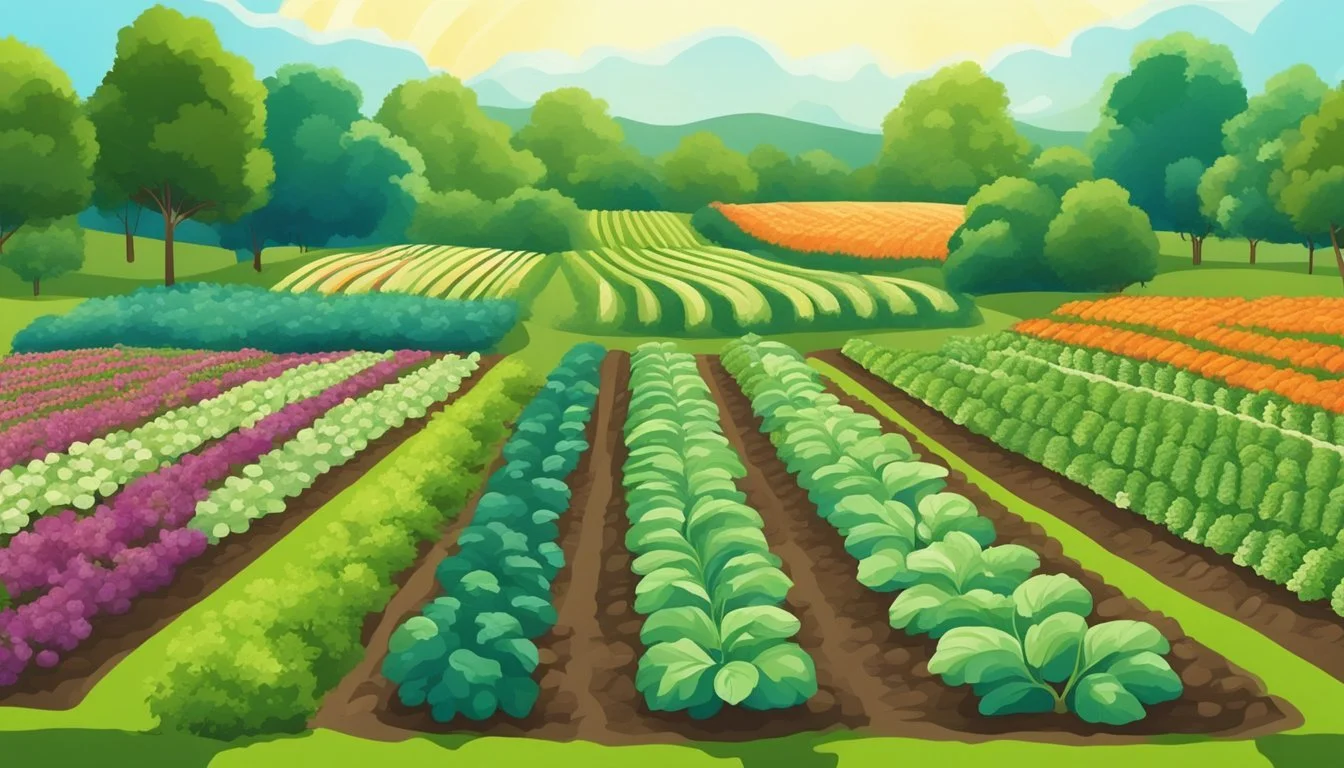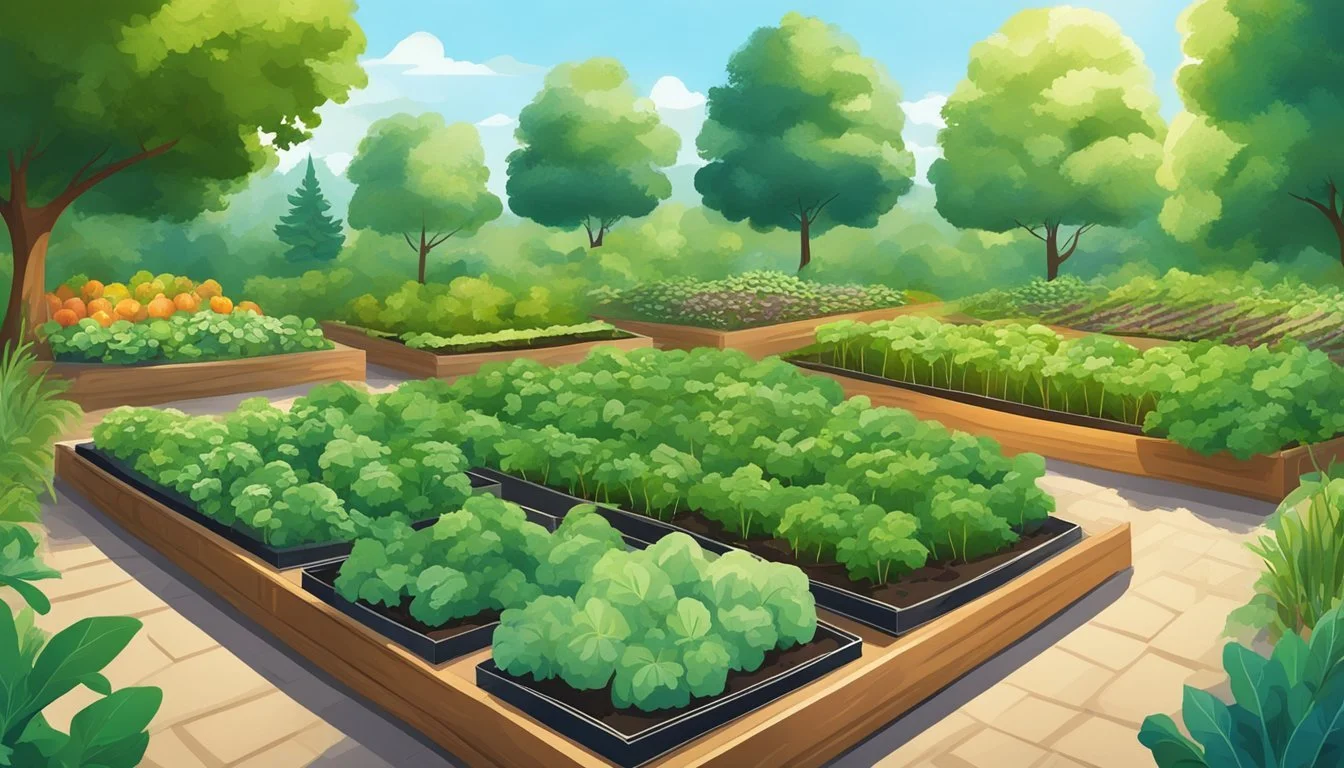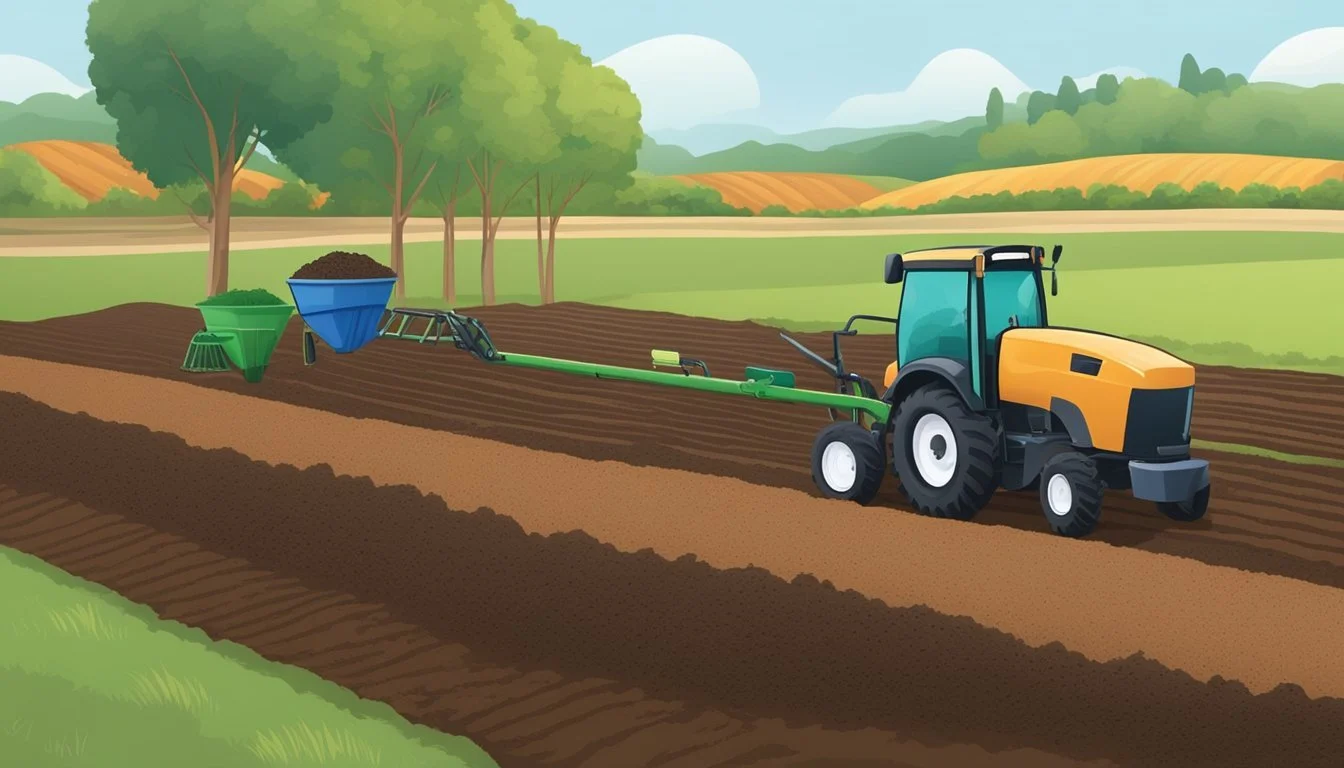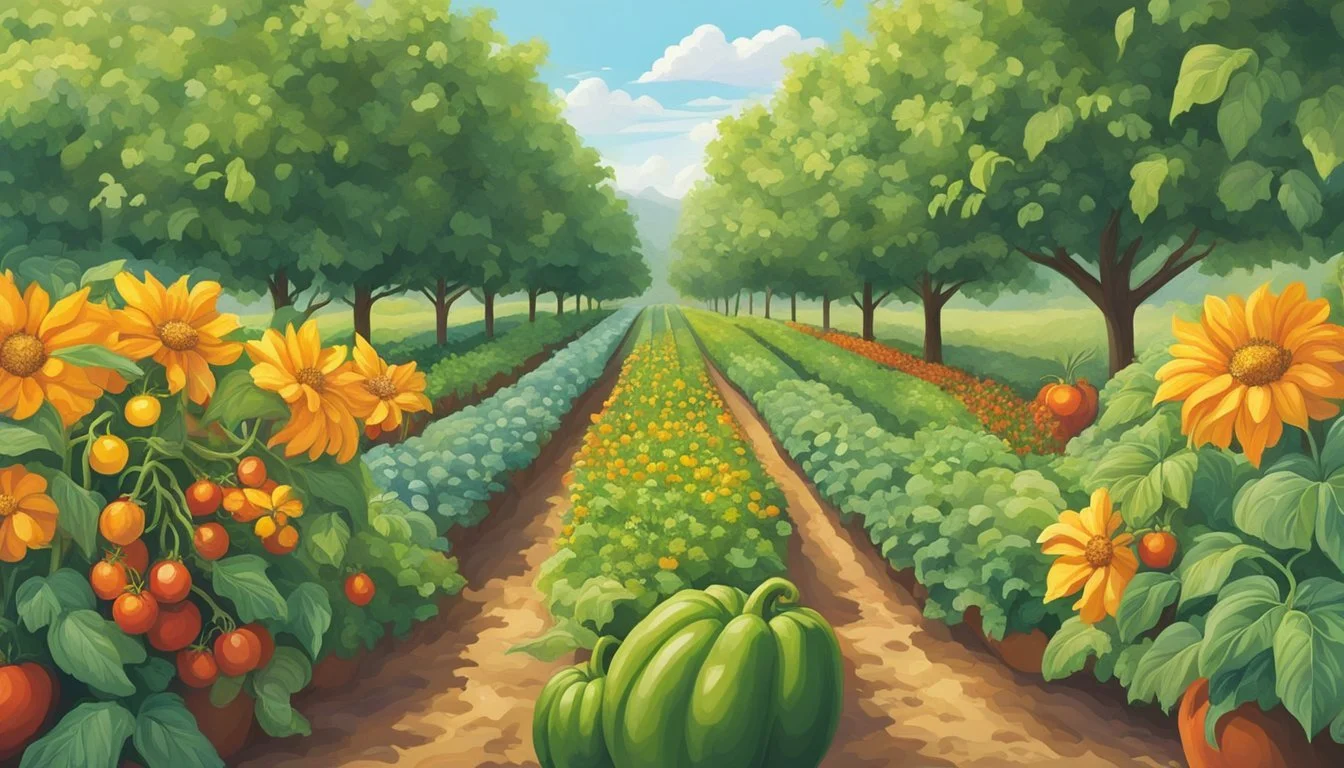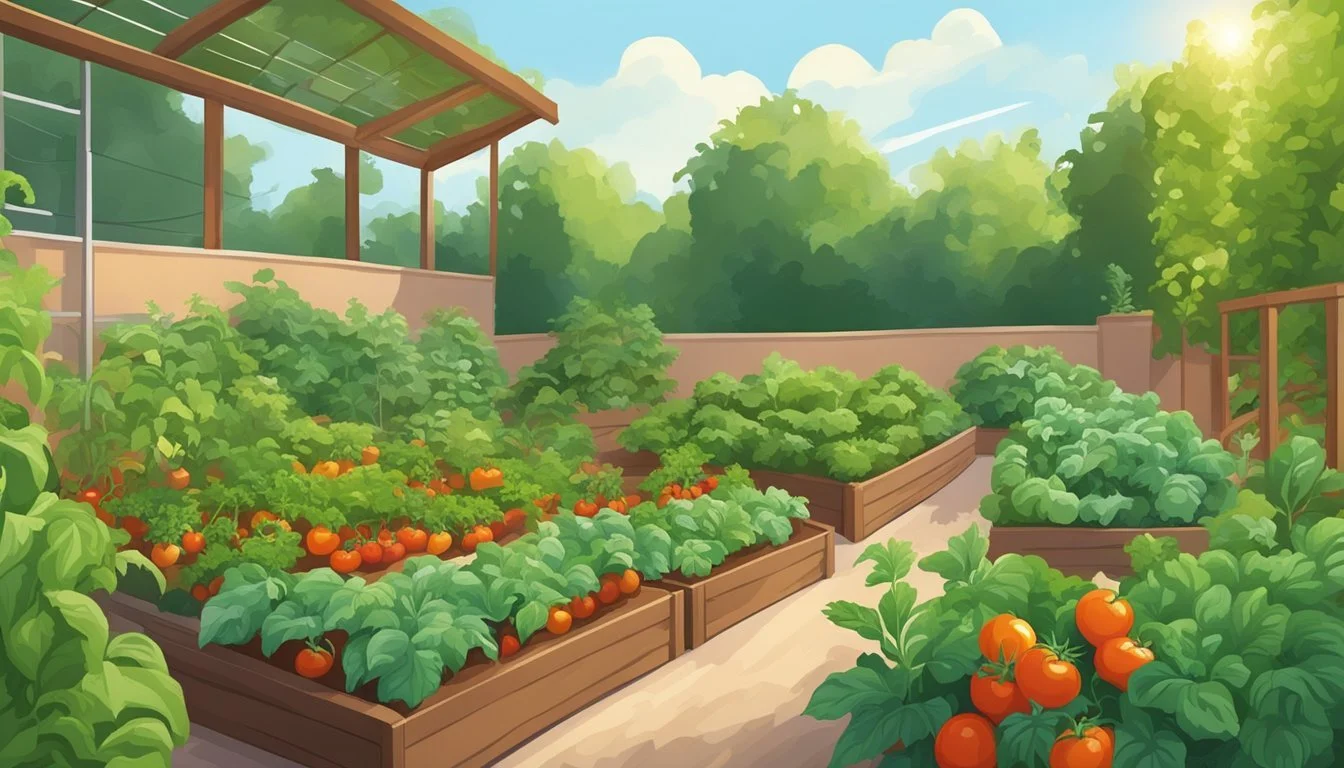Vegetable Gardening in Georgia
Essentials for a Thriving Harvest
This Article is Part of Our Guide on Vegetable Gardening by State
Vegetable gardening in Georgia presents a unique opportunity for residents to cultivate a diverse array of produce due to the state's favorable climate and extended growing season. Georgia's temperate conditions, characterized by hot summers and mild winters, are conducive to a multitude of vegetables that can thrive across its various USDA plant hardiness zones, which range from 6 to 9. Gardeners in the Peach State can enjoy a long and rewarding growing period, and with the right approach to soil preparation, planting schedules, and maintenance, they can maximize their garden's yield and health.
When embarking on a vegetable gardening journey in Georgia, location selection is critical. Adequate sunlight, good soil, and access to water are essential components for a successful garden. The state's soil composition ranges from the nutrient-rich red clay in the north to the sandy soils in the coastal regions, each requiring different amendments and care. By incorporating organic matter such as compost and following recommendations for fertilization and lime application, gardeners can create a fertile foundation ideal for vegetable growth.
Seasonal timing is also key in Georgia, as planting dates vary depending on the specific region and its associated frost dates. Cool-season vegetables such as lettuce, kale, and broccoli are typically sown in early spring or late summer, ensuring they mature during cooler temperatures, while warm-season crops like tomatoes, peppers, and cucumbers (how long do cucumbers last?) are planted after the last frost when the soil has warmed. With proper planning and mindful cultivation techniques, including mulching, irrigation, and pest management, Georgia's gardeners can ensure a bountiful and beautiful vegetable harvest.
Understanding Your Environment
Vegetable gardening in Georgia requires a nuanced understanding of the state's diverse climate and soil conditions, while ensuring the garden's location maximizes sunlight exposure. Key factors like climate dynamics, soil quality, and sunlight play pivotal roles in the success of a garden.
Climate Dynamics in Georgia
Georgia experiences a humid subtropical climate characterized by hot summers and mild winters. Rainfall is relatively consistent throughout the year, which can influence planting and harvesting times. Spring (March to May) and fall (mid-July to September) represent major planting periods. Gardeners should monitor local weather forecasts and climate patterns to optimize planting schedules.
Soil Composition and Quality
Soil in Georgia can vary greatly, but it commonly contains clay, which has good moisture-holding capacity. The recommended pH level for most vegetables is between 6.0 to 6.5, except for Irish potatoes which thrive in slightly more acidic soil (pH 5.0 to 6.0). A soil test is advised to assess nutrient content and pH. Testing your soil can gauge the need for lime and fertilizer to improve conditions for vegetable growth. Additionally, soil should be rich in organic matter to enhance its fertility and structure.
Sunlight and Location Requirements
Vegetables require an adequate amount of sunlight to flourish—typically, a minimum of six hours of direct sunlight per day. When selecting a garden site, one should look for areas that receive consistent sunlight while being protected from harsh winds. The location should also provide good internal drainage to prevent waterlogged soil, which can be detrimental to plant health.
Planning Your Vegetable Garden
Effective garden planning leverages limited space to yield an abundance of fresh produce through careful vegetable selection and timing. Understanding Georgia's climate and seasons is crucial for success.
Garden Space and Design
Garden layout must be strategic to maximize production in Georgia’s varied climate. Consider using raised beds to improve drainage and soil quality. Efficient use of space includes companion planting and the arrangement of crops to make the best use of light and shade:
Raised Beds: Standard sizes are 4 feet by 8 feet, ensuring easy access from both sides.
Companion Planting: For example, grow beans alongside cucumbers to save space.
To optimize resources, a garden map can ensure proper spacing and enhance plant health.
Choosing the Right Vegetables
Select vegetables based on personal preference and suitability to Georgia’s climate. Cool-season vegetables, like spinach and lettuce, grow best in spring and fall. Warm-season vegetables, such as tomatoes and peppers, thrive in summer:
Cool-Season Vegetables: Lettuce, spinach, radishes, and carrots.
Warm-Season Vegetables: Tomatoes, peppers, cucumbers, eggplant, and beans.
Quality of vegetables originates from appropriate vegetable variety selection; therefore, introduce new types alongside proven varieties to discover what grows best in your garden.
Planting Dates and Crop Rotation
Planting dates dictate the health and yield of your crops—timing matters for planting and harvest. For instance, greens and radish may be sown earlier than warm-season crops like tomatoes:
Spring Planting: Start seeds indoors for tomatoes and peppers, direct sow lettuce and spinach as frost subsides.
Fall Planting: Sow beets and cabbage several weeks before the first expected frost.
Crop rotation prevents soil depletion and reduces disease build-up:
Year Bed 1 Bed 2 Bed 3 1 Tomatoes Peppers Cucumbers 2 Beans Tomatoes Peppers 3 Cucumbers Beans Tomatoes
Incorporating crop rotation into your garden plan extends the viability of your garden space and improves the quality and quantity of harvests.
Soil Preparation
Effective soil preparation forms the backbone of a prolific vegetable garden in Georgia. It involves assessing the soil composition and nutrient levels, followed by amending the soil to create an ideal growing environment.
Testing and Amending Soil
Before planting, gardeners should test the soil to determine its pH level and nutrient composition. The optimal pH range for most vegetables is 6.0 to 6.5, except for Irish potatoes which prefer a more acidic environment, 5.0 to 6.0. Once the pH level is determined, the application of lime may be necessary to raise the pH, or sulfur can lower it if the soil is too alkaline.
Fertilizers should be used in accordance with the soil test results. They provide necessary nutrients like nitrogen, phosphorus, and potassium, which are essential for plant growth. It is imperative to follow the recommended rates to avoid over-fertilization, which can harm the plants and the environment.
Soil Nutrient Deficiency Symptom Amendment Nitrogen Yellowing of leaves Add compost or manure Phosphorus Dark green or purple Bone meal or rock phosphate Potassium Brown scorching on edges Potash or compost
Mulch and Organic Matter Integration
Incorporating organic matter into the soil is vital for improving soil structure and fertility. Sources of organic matter such as compost, decomposed leaves, or well-rotted manure enhance the soil's water retention and provide a slow release of nutrients.
Mulch serves multiple purposes; it helps retain soil moisture, suppresses weeds, and as it breaks down, further adds nutrients to the soil. A layer of mulch around vegetables should be 2 to 3 inches thick to be most effective; however, it should not be placed directly in contact with plant stems to avoid rot.
Applying organic matter and mulch are practices that should be regularly maintained to ensure soil vitality and to support a productive vegetable garden.
Planting Techniques
Successful vegetable gardening in Georgia hinges on understanding the appropriate planting techniques that cater to the state's unique climate and soil conditions. Precision in seed placement and transplant handling, alongside adapting to seasonal variations and implementing efficient watering systems, constitutes the foundation for a thriving garden.
Starting from Seeds or Transplants
When beginning a garden, one has to decide whether to start from seeds (how long do seeds last?) or use transplants. Seeds are more economical and offer a wider variety of plant options but require more time and care to establish. Conversely, transplants provide a head start and can be more forgiving for beginner gardeners. For optimal soil contact, seeds should be planted at a depth approximately three times their diameter.
Seeds: Direct sowing into warm, well-drained soil.
Transplants: Planting after the last frost in spring to avoid cold damage.
Seasonal Planting Considerations
Georgia's gardening calendar is generally split into two main seasons: spring planting and fall planting. Each season has specific plants that are more likely to succeed due to the temperature conditions.
Spring Planting: Focus on crops that tolerate the transition from cool to warm weather. Planting dates should reflect the last expected frost.
Fall Planting: Ideal for planting cool-season crops that can handle the mild Georgia winters. Many fall-planted crops can be sown or transplanted several weeks before the first expected frost.
Table: Seasonal Planting Guide
Season Warm-weather Crops Cool-weather Crops Spring Tomatoes, Peppers Lettuce, Spinach Fall --- Broccoli, Kale
Watering and Irrigation Systems
Proper watering is crucial for plant health. Georgia's heat necessitates consistent moisture, especially during the warm spring and summer months. Soaker hoses and drip irrigation systems are recommended for their efficiency in delivering water directly to the plant roots, conserving water, and reducing disease spread.
Soaker Hoses: Ideal for keeping the soil evenly moist while minimizing leaf wetness.
Irrigation Systems: Automated systems can be timed to water early in the morning to reduce evaporation losses.
Remember to adjust watering schedules based on rainfall and to check soil moisture regularly to prevent overwatering.
Garden Maintenance
Effective garden maintenance is essential for a thriving vegetable garden in Georgia. Gardeners should focus on managing weeds, diseases, and pests to ensure healthy plant growth and a bountiful harvest.
Weed Management
Weeds compete with vegetables for nutrients, light, and water. Regular weeding is crucial; either by hand or with the aid of tools. Mulching is a beneficial practice as it suppresses weed growth and retains soil moisture. Organic mulches such as straw or bark chips can be applied around the plants. For best results, a mulch layer should be about 2-3 inches thick, but it should not come in direct contact with plant stems to prevent rot.
Mulch Material Thickness Benefits Straw 3 inches Moisture retention, temperature regulation Bark Chips 2 inches Long-lasting, suppresses weeds
Disease and Pest Control
Vegetables in Georgia are susceptible to various diseases and pests, including aphids, nematodes, and more. Proactive monitoring and early identification of problems are key. Gardeners should look for signs of diseases such as unusual spots, rotting, or wilting. Similarly, pests like aphids and nematodes can cause significant damage if left unchecked.
To control diseases and pests:
Ensure proper plant spacing to improve air circulation.
Remove and dispose of diseased plant material promptly to prevent spread.
Utilize organic or chemical controls as necessary, following all label instructions.
For aphids, a strong water spray or insecticidal soap can be effective. Nematode control often requires crop rotation or the use of nematode-resistant plant varieties. It's important to identify the specific disease or pest before treatment to choose the correct control method. Regular inspections and prompt action are key components of successful garden maintenance.
Harvesting and Post-Harvest
Successful vegetable gardening in Georgia encompasses more than just planting and maintenance; it includes proper harvesting techniques and post-harvest handling. Knowing when and how to harvest, as well as how to store, can, and freeze your produce, ensures quality and extends the enjoyment of your garden's bounty.
Harvesting Techniques and Timing
Vegetables are best harvested at the peak of their maturity to ensure the highest nutritional content and the best flavor. They should be carefully picked to prevent damaging the plant or the vegetable. For example:
Leafy greens: Harvest in the morning when the leaves are crispest.
Root vegetables: Pull when the soil is dry to avoid mud clinging to them.
Tomatoes: Pick when evenly colored and slightly soft to the touch.
Here's a simplified timing guide for harvesting vegetables in Georgia:
Spring crops, such as lettuce and spinach, should be harvested before the summer heat bolts the plant.
Summer vegetables, like tomatoes and peppers, typically come to harvest in the late summer months.
Fall vegetables, including pumpkins and squash, should be picked before the first frost.
Canning, Freezing, and Storage
Proper storage is essential to preserving the quality of the harvest. There are several methods to extend shelf-life, such as canning and freezing. When canning vegetables, one must ensure all equipment is sterile, and the proper canning techniques are used to prevent foodborne illnesses. Vegetables suitable for canning include:
Tomatoes: Use a pressure canner for acidic fruits.
Green beans: Can be canned but must be done using a pressure canner to ensure safety.
Freezing is another viable option for preserving the harvest, and almost all vegetables are suitable for this method. Here's how to do it properly:
Blanch vegetables in boiling water.
Cool immediately in icy water to halt cooking.
Dry and pack in airtight containers.
For non-canned storage:
Store root vegetables like carrots and beets in cool, humid environments.
Keep onions and garlic in a cool, dry, well-ventilated space.
Certain vegetables, like potatoes, should be kept in the dark to prevent greening and sprouting.
Special Topics in Vegetable Gardening
In Georgia, vegetable gardening can flourish with the right practices and adaptations. This section delves into organic gardening methods, maximizing yields in limited spaces, and leveraging community resources for garden success.
Organic Gardening Practices
When tending to a vegetable garden in Georgia, gardeners can enhance the quality of their produce by adopting organic practices. Utilizing organic matter, such as composted leaves, is beneficial for enriching the soil and improving its structure. For instance, kale and radishes, which thrive in well-drained, nutrient-rich soil, can significantly benefit from the addition of compost. Gardeners should also be aware of suitable cropping systems and pest management techniques suitable for organic gardens.
Crop Rotation: Alternate crops like sweet potatoes with broccoli to manage soil nutrients and reduce disease risk.
Natural Pest Control: Planting herbs that repel insects can help protect crops like watermelon without resorting to chemical pesticides.
Using Containers and Small Spaces
Vegetable gardens don't require a vast expanse of land; they can be cultivated in containers and small urban spaces. Containers must have excellent drainage and be filled with high-quality potting mix to ensure the health of the plants. Gardening in small spaces or containers is especially suitable for growing herbs and vegetables like sweet potatoes and kale, which can be harvested on a small scale yet yield a rewarding taste and nutritional quality.
Vertical Gardening: Utilize trellises for vining plants to optimize space.
Container Selection: Choose containers of various sizes to accommodate different vegetable root systems.
Community Resources and Extension Services
Local extension offices offer a treasure trove of resources for vegetable gardeners. They provide guides, educational events, and personalized assistance. Gardeners in any city within Georgia can reach out to these services for advice on local garden practices, soil testing, and selecting the right varieties of vegetables for the region.
Soil Testing: Contact the extension office to learn how to test and adjust garden soil for optimal vegetable growth.
Educational Workshops: Attend local events and workshops for hands-on learning experiences.
By implementing the suggested practices, gardeners can ensure their vegetable garden is productive and sustainable.
Seasonal Vegetable Gardening in Georgia
Seasonal gardening in Georgia allows gardeners to take advantage of the state's extended warm seasons. With careful planning, one can enjoy a variety of vegetables harvested from spring through fall.
Creating a Spring Garden
In Georgia, the spring planting season kicks off as early as late March to early April. To optimize the spring garden, one should focus on crops that can tolerate the last frosts and thrive in the warming soil. Peas and green beans are excellent choices to start with due to their ability to withstand cooler temperatures.
Planting Dates:
Peas: as early as March
Green beans: after the last expected frost, typically in April
Crops like tomatoes, peppers, and cucumbers should be started indoors and transplanted after the danger of frost has passed. These warm-season vegetables will flourish as the temperatures increase.
Preparing for a Successful Fall Garden
Planning for the fall garden should begin in the heat of summer. In Georgia, fall gardens benefit from the warm temperatures extending into September and even October. To ensure a successful fall harvest, one must select crops that will mature before the first frosts arrive and those that can endure cooler temperatures later in the season.
For a fruitful fall garden, vegetables like pumpkin and okra can be planted in the summer months, as they require a warm growth period before their full maturation in fall. Additionally, the garden should be lined with mulch to help retain moisture during the earlier part of the fall season when the heat can still be intense.
Crops for Fall:
Pumpkin: plant in late May to June for an October harvest
Okra: plant from March to July for a harvest that continues into the fall
By respecting the unique planting dates and climate needs of each vegetable, Georgia gardeners can extend their harvest and enjoy a variety of fresh produce throughout the year.
Conclusion
Vegetable gardening in Georgia offers ample opportunities for beginners and seasoned gardeners alike, thanks to the state's advantageous climate. The long growing season and diverse weather patterns across five zones allow for a variety of vegetables to flourish. Gardeners should plan their planting schedule strategically, aiming for spring post-frost and the conducive fall season.
Key Considerations for Georgian Gardeners:
Climate: Understanding local climatic conditions is essential. Northern zones experience cooler temperatures, while southern regions benefit from a milder climate.
Soil Preparation: Investing time in soil testing and amendment paves the way for a bountiful harvest.
Pest Control: Regular monitoring and environmentally-friendly practices help mitigate pests and diseases.
Water Management: Efficient irrigation practices ensure vegetables receive the right amount of moisture without waste.
Effective Strategies:
Utilize mulch to retain soil moisture and suppress weeds.
Employ crop rotation to maintain soil health and reduce pest issues.
Research local vegetable varieties for best results.
Resources for Gardeners in Georgia:
UGA Cooperative Extension: Provides regional gardening guides.
Local gardening clubs: Offer community-based support and shared knowledge.
Whether one's home garden is for personal enjoyment or to provide nutritious food for the family, attention to these tips will invariably lead to successful vegetable gardening in Georgia.

